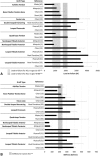What Factors Influence the Biomechanical Properties of Allograft Tissue for ACL Reconstruction? A Systematic Review
- PMID: 28353048
- PMCID: PMC5599386
- DOI: 10.1007/s11999-017-5330-9
What Factors Influence the Biomechanical Properties of Allograft Tissue for ACL Reconstruction? A Systematic Review
Abstract
Background: Allograft tissue is used in 22% to 42% of anterior cruciate ligament (ACL) reconstructions. Clinical outcomes have been inconsistent with allograft tissue, with some series reporting no differences in outcomes and others reporting increased risk of failure. There are numerous variations in processing and preparation that may influence the eventual performance of allograft tissue in ACL reconstruction. We sought to perform a systematic review to summarize the factors that affect the biomechanical properties of allograft tissue for use in ACL reconstruction. Many factors might impact the biomechanical properties of allograft tissue, and these should be understood when considering using allograft tissue or when reporting outcomes from allograft reconstruction.
Questions/purposes: What factors affect the biomechanical properties of allograft tissue used for ACL reconstruction?
Methods: We performed a systematic review to identify studies on factors that influence the biomechanical properties of allograft tissue through PubMed and SCOPUS databases. We included cadaveric and animal studies that reported on results of biomechanical testing, whereas studies on fixation, histologic evaluation, and clinical outcomes were excluded. There were 319 unique publications identified through the search with 48 identified as relevant to answering the study question. For each study, we recorded the type of tissue tested, parameters investigated, and the effects on biomechanical behavior, including load to failure and stiffness. Primary factors identified to influence allograft tissue properties were graft tissue type, sterilization methods (irradiation and chemical processing), graft preparation, donor parameters, and biologic adjuncts.
Results: Load to failure and graft stiffness varied across different tissue types, with nonlooped tibialis grafts exhibiting the lowest values. Studies on low-dose irradiation showed variable effects, whereas high-dose irradiation consistently produced decreased load to failure and stiffness values. Various chemical sterilization measures were also associated with negative effects on biomechanical properties. Prolonged freezing decreased load to failure, ultimate stress, and ultimate strain. Up to eight freeze-thaw cycles did not lead to differences in biomechanical properties of cadaveric grafts. Regional differences were noted in patellar tendon grafts, with the central third showing the highest load to failure and stiffness. Graft diameter strongly contributed to load-to-failure measurements. Age older than 40 years, and especially older than 65 years, negatively impacted biomechanical properties, whereas gender had minimal effect on the properties of allograft tissue. Biologic adjuncts show potential for improving in vivo properties of allograft tissue.
Conclusions: Future clinical studies on allograft ACL reconstruction should investigate in vivo graft performance with standardized allograft processing and preparation methods that limit the negative effects on the biomechanical properties of tissue. Additionally, biologic adjuncts may improve the biomechanical properties of allograft tissue, although future preclinical and clinical studies are necessary to clarify the role of these treatments.
Clinical relevance: Based on the findings of this systematic review that emphasize biomechanical properties of ACL allografts, surgeons should favor the use of central third patellar tendon or looped soft tissue grafts, maximize graft cross-sectional area, and favor grafts from donors younger than 40 years of age while avoiding grafts subjected to radiation doses > 20 kGy, chemical processing, or greater than eight freeze-thaw cycles.
Keywords: Allograft Tissue; Anterior Cruciate Ligament; Anterior Cruciate Ligament Reconstruction; Biomechanical Property; Patellar Tendon.
Figures


Similar articles
-
What Is the Mid-term Failure Rate of Revision ACL Reconstruction? A Systematic Review.Clin Orthop Relat Res. 2017 Oct;475(10):2484-2499. doi: 10.1007/s11999-017-5379-5. Clin Orthop Relat Res. 2017. PMID: 28493217 Free PMC article.
-
"Proprietary Processed" Allografts: Clinical Outcomes and Biomechanical Properties in Anterior Cruciate Ligament Reconstruction.Am J Sports Med. 2017 Nov;45(13):3158-3167. doi: 10.1177/0363546516687540. Epub 2017 Feb 14. Am J Sports Med. 2017. PMID: 28195744
-
Biomechanical properties of common graft choices for anterior cruciate ligament reconstruction: A systematic review.Clin Biomech (Bristol). 2022 May;95:105636. doi: 10.1016/j.clinbiomech.2022.105636. Epub 2022 Apr 1. Clin Biomech (Bristol). 2022. PMID: 35428007
-
Autograft versus nonirradiated allograft tissue for anterior cruciate ligament reconstruction: a systematic review.Am J Sports Med. 2014 Feb;42(2):492-9. doi: 10.1177/0363546513497566. Epub 2013 Aug 8. Am J Sports Med. 2014. PMID: 23928319 Free PMC article.
-
Long-term results after anterior cruciate ligament reconstruction using patellar tendon versus hamstring tendon autograft with a minimum follow-up of 10 years-a systematic review.Arch Orthop Trauma Surg. 2023 Jul;143(7):4277-4289. doi: 10.1007/s00402-022-04687-9. Epub 2022 Nov 28. Arch Orthop Trauma Surg. 2023. PMID: 36441213 Free PMC article.
Cited by
-
Effects of and Response to Mechanical Loading on the Knee.Sports Med. 2022 Feb;52(2):201-235. doi: 10.1007/s40279-021-01579-7. Epub 2021 Oct 20. Sports Med. 2022. PMID: 34669175 Review.
-
Temperature-based protection of biochemical and biomechanical characteristics during 25 kGy 60Co irradiation for allograft tendons.BMC Musculoskelet Disord. 2025 Aug 1;26(1):741. doi: 10.1186/s12891-025-09016-w. BMC Musculoskelet Disord. 2025. PMID: 40751149 Free PMC article.
-
Complications and Outcomes of Chemically Treated Allograft in Preadolescent and Adolescent Patients Undergoing Medial Patellofemoral Ligament Reconstruction.Orthop J Sports Med. 2025 May 1;13(4):23259671251334148. doi: 10.1177/23259671251334148. eCollection 2025 Apr. Orthop J Sports Med. 2025. PMID: 40322750 Free PMC article.
-
The use of allograft tendons in primary ACL reconstruction.Knee Surg Sports Traumatol Arthrosc. 2019 Jun;27(6):1754-1770. doi: 10.1007/s00167-019-05440-3. Epub 2019 Mar 4. Knee Surg Sports Traumatol Arthrosc. 2019. PMID: 30830297 Review.
-
Seeing Beyond Morphology-Standardized Stress MRI to Assess Human Knee Joint Instability.Diagnostics (Basel). 2021 Jun 4;11(6):1035. doi: 10.3390/diagnostics11061035. Diagnostics (Basel). 2021. PMID: 34199917 Free PMC article.
References
-
- American Academy of Orthopaedic Surgeons . Allografts for ACL Reconstruction Survey Report. Rosemont, IL, USA: American Orthopaedic Society for Sports Medicine; 2013.
Publication types
MeSH terms
LinkOut - more resources
Full Text Sources
Other Literature Sources
Medical

